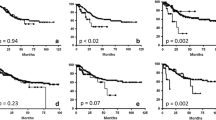Abstract
Purpose
Large pharyngocutaneous fistulas or pharyngostomes are difficult complications to solve, which generate high morbidity and mortality, a poor quality of life and an increase in health costs. Its management must be comprehensive according to general, local and regional factors. We review our experience in treating these pharyngostomes with free flaps.
Methods
Retrospective study analyzing the results of the reconstruction of 50 patients using free flaps during the period 1991–2019. We exclude patients who required free-flap reconstruction due to primary tumor or those who resolved in other ways. The different types of reconstruction were classified into three types.
Results
The 86% (43) were men, and the mean age was 57 years (25–76). In 48% (24/50) the flaps performed were anterolateral thigh (ALT), in 24% (12/50) forearm, in 22% (11/50) parascapular, in 4% (2/50) jejunum and in 2% (1/50) ulnar. A salivary by-pass was placed in 74% (37/50) of the cases. Four cases (8%) presented flap necrosis and two patients died due to treatment. In 86% (43/50) there was some type of complication and 34% (17/50) required surgical revision. 94% (45/48) were able to reintroduce oral feeding.
Conclusion
According to our experience, we proposed a regardless size classification: type 1 when only a mucous closure (pharynx) are required (6%), type 2 exclusively skin for cutaneous coverage (10%) and mixed type 3 (mucous and skin) (84%). The treatment of large pharyngostomes with free flaps, despite its complexity, is in our experience the best option for its management.


Similar content being viewed by others
References
Rodrigo JP, López F, Llorente JL, Álvarez-Marcos C, Suárez C (2015) Results of total laryngectomy as treatment for locally advanced laryngeal cancer in the organ-preservation era. Acta Otorrinolaringol Esp 66(3):132–138
Klozar J, Cada Z, Koslabova E (2012) Complications of total laryngectomy in the era of chemoradiation. Eur Arch Oto-Rhino-Laryngol 269(1):289–293
Casasayas M, Sansa A, García-Lorenzo J, López M, Orús C, Peláez X et al (2019) Pharyngocutaneous fistula after total laryngectomy: multivariate analysis of risk factors and a severity-based classification proposal. Eur Arch Oto-Rhino-Laryngol 276(1):143–151
van Bokhorst-de van der Schueren MA, van Leeuwen PA, Sauerwein HP, Kuik DJ, Snow GB, Quak JJ (1997) Assessment of malnutrition parameters in head and neck cancer and their relation to postoperative complications. Head Neck 19(5):419–425
Sumarroca A, Rodríguez-Bauzà E, Lop-Gros J, García J, López M, Quer M et al (2019) Repair of post-laryngectomy pharyngocutaneous fistulas using a pectoralis major flap. Braz J Otorhinolaryngol 85(3):351–356
Sevilla García MA, Suárez Fente V, Rodrigo Tapia JP, Llorente Pendás JL (2006) Montgomery salivary bypass tube: a simple solution for pharyngocutaneous fistulas. Acta Otorrinolaringol Esp 57(10):467–470
Guthrie RH, Kovachev D, Schwager RG (1974) Pharyngostome repairs. Surg Clin North Am 54(4):767–786
Ragbir M, Brown JS, Mehanna H (2016) Reconstructive considerations in head and neck surgical oncology: United Kingdom National Multidisciplinary Guidelines. J Laryngol Otol 130(S2):S191–S197
Pegan A, Rašić I, Košec A, Solter D, Vagić D, Bedeković V et al (2018) Type II hypopharyngeal defect reconstruction-a single institution experience. Acta Clin Croat 57(4):673–680
Hyun D-J, Joo Y-H, Kim M-S (2017) Impact of pre-operative body mass index in head and neck cancer patients undergoing microvascular reconstruction. J Laryngol Otol 131(11):972–976
Formeister EJ, Sean Alemi A, El-Sayed I, George JR, Ha P, Daniel Knott P et al (2018) Shorter interval between radiation therapy and salvage laryngopharyngeal surgery increases complication rates following microvascular free tissue transfer. Am J Otolaryngol 39(5):548–552
Llorente JL, López F, Suárez V, Fueyo Á, Carnero S, Martín C et al (2014) Free flap reconstruction in the head and neck. Indications, technical aspects and outcomes. Acta Otorrinolaringol Esp 65(1):33–42
López F, Obeso S, Camporro D, Fueyo Á, Suárez C, Llorente JL (2013) Outcomes following pharyngolaryngectomy with fasciocutaneous free flap reconstruction and salivary bypass tube. Laryngoscope 123(3):591–596
Haidar YM, Tripathi PB, Tjoa T, Walia S, Zhang L, Chen Y et al (2018) Antibiotic prophylaxis in clean-contaminated head and neck cases with microvascular free flap reconstruction: a systematic review and meta-analysis. Head Neck 40(2):417–427
Morinière S, Gorphe P, Espitalier F, Blanchard D, Fakhry N, Saroul N et al (2019) Assessment of swallowing function after circumferential pharyngolaryngectomy. A multicenter study by the GETTEC group. Eur Ann Otorhinolaryngol Head Neck Dis 136(1):3–5
Funding
The present investigation has not received specific aid from public agencies, commercial or non-profit entities.
Author information
Authors and Affiliations
Contributions
All authors contributed to the study conception and design. Material preparation, data collection and analysis were performed by PS and JLL. The first draft of the manuscript was written by JLL and all authors commented on previous versions of the manuscript. All authors read and approved the final manuscript.
Corresponding author
Ethics declarations
Conflict of interest
The authors declare that they have no conflict of interest.
Ethical approval
This article does not contain any studies with human participants or animals performed by any of the authors.
Informed consent
Additional informed consent was obtained from all individual participants for whom identifying information is included in this article.
Additional information
Publisher's Note
Springer Nature remains neutral with regard to jurisdictional claims in published maps and institutional affiliations.
Rights and permissions
About this article
Cite this article
Llorente, J.L., Sánchez, P., López, F. et al. Closing of large pharyngostomes with free flaps and proposal of a new classification. Eur Arch Otorhinolaryngol 277, 3137–3144 (2020). https://doi.org/10.1007/s00405-020-06010-x
Received:
Accepted:
Published:
Issue Date:
DOI: https://doi.org/10.1007/s00405-020-06010-x




